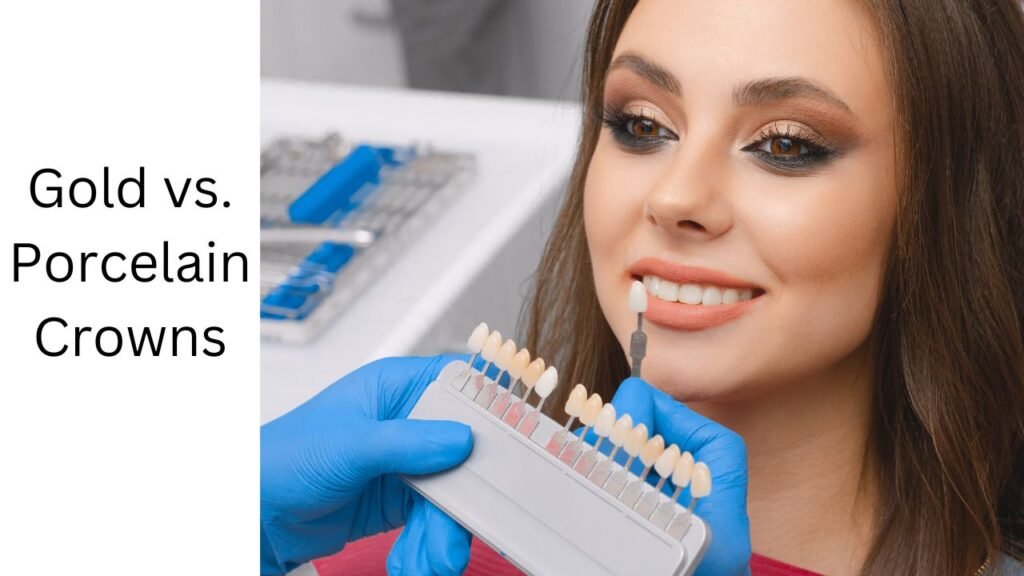A Comprehensive Guide to Choosing the Perfect Dental Crown
When dealing with a damaged or weakened tooth, a dental crown is often the best solution. Crowns can restore function, protect the tooth, and enhance its appearance. The two most popular types of crowns are gold and porcelain.
Understanding the differences between these materials can help you make an informed decision tailored to your needs. This guide will walk you through the essential factors to consider, helping you choose the best crown material for your situation.
Understanding Dental Crowns

Dental crowns are caps placed over a tooth to:
- Protect Weak Teeth: They shield compromised teeth from further damage.
- Restore Function: Crowns enable normal chewing and speaking.
- Improve Appearance: They enhance the look of damaged or discolored teeth.
Selecting the right crown material involves balancing factors such as durability, aesthetics, and cost. Let’s dive into the details of gold and porcelain crowns to find the right fit for you.
Gold Crowns: Timeless Durability and Strength
Types of Gold Alloys
Gold crowns are crafted from various gold alloys, each offering unique properties:
- Yellow Gold: A traditional choice, known for its strength and classic appearance. Mixed with copper and other metals, it’s highly durable.
- White Gold: Contains gold mixed with palladium or nickel, offering a more subdued, silver-like appearance.
Benefits of Gold Crowns
Gold crowns have several advantages:
- Unmatched Durability: Gold crowns are renowned for their longevity, often lasting between 15 and 30 years. They withstand wear and tear from chewing better than other materials.
- Exceptional Strength: They can endure significant bite forces without chipping or cracking, making them ideal for molars and other high-stress areas.
- Biocompatibility: Gold is well-tolerated by the body, reducing the risk of allergic reactions and gum irritation.
Drawbacks of Gold Crowns
Despite their strengths, gold crowns have some limitations:
- Aesthetics: The metallic color of gold crowns can be noticeable, which might not be desirable for front teeth where appearance is more important.
- Cost: Gold crowns are generally more expensive due to the cost of the material and the labor involved in crafting them.
Procedure for Gold Crowns
The process involves:
- Preparation: Your dentist reshapes the tooth and takes impressions.
- Temporary Crown: A temporary crown is placed while the permanent one is being made.
- Final Fitting: Once the gold crown is ready, it’s fitted onto the tooth and adjusted for a perfect fit.
Porcelain Crowns: Aesthetic Appeal and Versatility
Types of Porcelain Crowns
Porcelain crowns come in several forms:
- Zirconia Crowns: Made from zirconium dioxide, they offer high strength and resistance to chipping, making them a robust choice.
- Feldspathic Porcelain Crowns: Known for their natural look and ability to blend seamlessly with surrounding teeth, though they are more prone to chipping.
Benefits of Porcelain Crowns
Porcelain crowns offer distinct advantages:
- Natural Appearance: Porcelain crowns can be color-matched to blend with your natural teeth, providing a more aesthetically pleasing result, especially for front teeth.
- Versatility: They can be customized to match the shape and color of your natural teeth, making them suitable for both front and back teeth.
- Gum Health: The smooth surface of porcelain crowns can reduce irritation and promote better gum health.
Drawbacks of Porcelain Crowns
While porcelain crowns are attractive, they have some drawbacks:
- Durability: Porcelain crowns are generally not as durable as gold. They can chip or crack, especially if made from feldspathic porcelain. However, using zirconia cores or layered porcelain can enhance their durability.
- Strength: They may not withstand heavy bite forces as well as gold crowns.
Procedure for Porcelain Crowns
The steps for getting a porcelain crown are similar:
- Preparation: The dentist prepares your tooth and takes impressions.
- Temporary Crown: You’ll receive a temporary crown while the permanent porcelain crown is crafted.
- Final Fitting: The permanent crown is placed and adjusted to ensure a proper fit.
Comparing Gold and Porcelain Crowns
To help you decide, here’s a detailed comparison:
| Factor | Gold Crowns | Porcelain Crowns |
|---|---|---|
| Durability | High; lasts 15-30 years | Moderate; improved with zirconia cores or layered porcelain |
| Strength | Very strong; ideal for heavy chewing | Moderate; can chip or crack, especially feldspathic types |
| Aesthetics | Metallic; less natural | Natural-looking; customizable color |
| Biocompatibility | Excellent; rarely causes reactions | Good; some rare allergic reactions |
| Cost | Generally higher | Generally lower; varies by insurance coverage |
Factors Influencing Your Choice:
- Dentist’s Recommendation: Your dentist can provide personalized advice based on your specific dental needs.
- Personal Preferences: Decide whether aesthetics or durability is more important to you.
- Budget Considerations: Evaluate the costs and check your insurance coverage for different crown types.
Conclusion: Making the Right Choice
Choosing between gold and porcelain crowns is crucial for achieving the best results in both function and appearance. Gold crowns offer unparalleled durability and strength but may not be ideal for those seeking a natural look. Porcelain crowns provide excellent aesthetics and versatility but may not be as durable.
To find the best crown material for your needs, schedule a consultation with your dentist. They can assess your individual situation and help you make an informed decision. With the right crown, you can restore your dental health and smile with confidence.
Find Your Perfect Dentist
Book appointments with top-rated dentists in your area